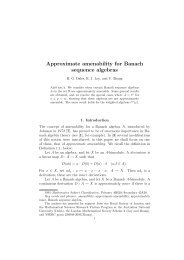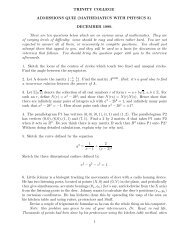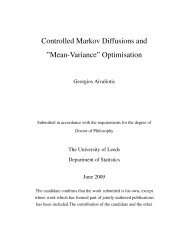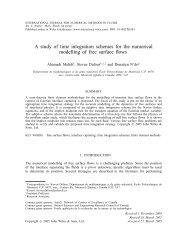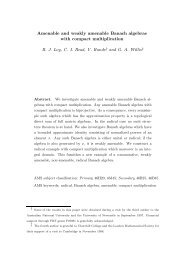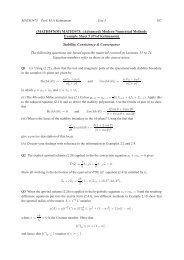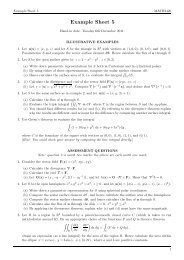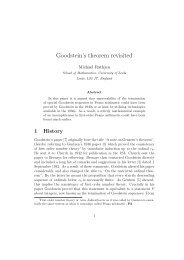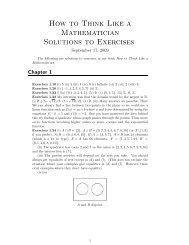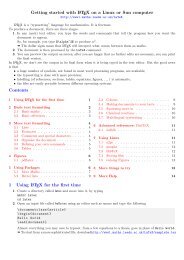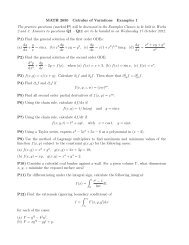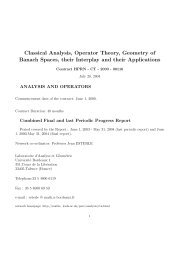Taylor-Couette flow of viscoplastic fluids
Taylor-Couette flow of viscoplastic fluids
Taylor-Couette flow of viscoplastic fluids
Create successful ePaper yourself
Turn your PDF publications into a flip-book with our unique Google optimized e-Paper software.
17 th International <strong>Couette</strong>-<strong>Taylor</strong> Workshop, Leeds, July 25-27, 2011<br />
<strong>Taylor</strong>-<strong>Couette</strong> <strong>flow</strong> <strong>of</strong> <strong>viscoplastic</strong> <strong>fluids</strong><br />
B. Alibenyahia 1 , C. Lemaitre 2 , C. Nouar 3<br />
1 University <strong>of</strong> Blida, Algeria<br />
2 LRGP-ENSIC, 1 rue Grandville, BP 20451, 54001 Nancy Cedex, France<br />
3 LEMTA, UMR 7563 (CNRS), 2 avenue de la forêt de Haye, BP 160, 54504 Vandoeuvre<br />
Cedex, France<br />
The objective <strong>of</strong> the present communication is to study the stability <strong>of</strong> a shear-thinning fluid in<br />
<strong>Taylor</strong>-<strong>Couette</strong> <strong>flow</strong>. Few results exist in the literature for nonlinear purely viscous <strong>fluids</strong> and<br />
they are sometimes in disagreement. Recently, it has been indicated [1] that for highly shearthinning<br />
character, the primary instability would be characterized by longitudinal structures.<br />
This surprising result led us to perform a threedimensional stability analysis.<br />
Problem description<br />
We study the <strong>flow</strong> <strong>of</strong> an incompressible fluid between two infinitely long cylinders. The inner<br />
cylinder, <strong>of</strong> radius ˆR 1 , rotates with an angular velocity ˆΩ 1 and the outer cylinder, <strong>of</strong> radius ˆR 2 ,<br />
is at rest. The nondimensional equations <strong>of</strong> motion read<br />
∇.U = 0 , ∂ t U+ Re(U.∇)U =−∇P+∇.τ. (1)<br />
where U is the velocity, P the pressure and τ the deviatoric stress tensor. The Reynolds number<br />
is defined by Re= ˆρ ˆR 1 ˆΩ 1 ˆ d/ ˆµ re f . These equations have been put into a nondimensional form<br />
using the gap thickness ˆ d = ˆR 2 − ˆR 1 , the inner cylinder velocity ˆΩ 1 ˆR 1 , and the reference viscosity<br />
ˆµ re f that will be precised later. We consider shear-thinning <strong>fluids</strong>, i.e. <strong>fluids</strong> which viscosity<br />
decreases with increasing shear-stress. We focus on two rheological models, which read in their<br />
nondimensional form<br />
Power law model: τ = µ ˙γ = ˙γ n−1 ˙γ<br />
[ ]<br />
Bingham model: τ = µ ˙γ = 1+ Ḃ γ<br />
˙γ ⇔ τ > B; ˙γ = 0⇔τ ≤ B.<br />
ˆτ 0<br />
The Bingham number is defined by B =<br />
ˆµ p ˆR 1 ˆΩ 1 / dˆ<br />
where ˆτ 0 is the yield stress, ˆµ p is the<br />
plastic viscosity, ˙γ and τ are the second invariant <strong>of</strong> the strain-rate tensor ˙γ and the deviatoric<br />
√ √<br />
stress tensor τ that are defined as follows: ˙γ = ∇U + ∇U T 1<br />
; ˙γ =<br />
2 ˙γ 1<br />
i j ˙γ i j ;τ =<br />
2 τ i j τ i j . The<br />
reference viscosity ˆµ re f is ˆµ p for the Bingham model and the nominal viscosity ˆK ( ˆR 1 ˆΩ 1 / d ˆ<br />
n−1<br />
,<br />
ˆK being the fluid consistency index, for the power law model.
Re cw<br />
700<br />
600<br />
500<br />
400<br />
300<br />
200<br />
100<br />
η = 0.5<br />
η = 0.4<br />
η = 0.8<br />
η = 0.9<br />
0<br />
0.2 0.4 0.6 0.8 1<br />
n<br />
axial wavenumber, k<br />
5.5<br />
5<br />
4.5<br />
4<br />
3.5<br />
3<br />
η = 0.4<br />
η = 0.5<br />
η = 0.66<br />
η = 0.8<br />
η = 0.9<br />
2.5<br />
0.2 0.4 0.6 0.8 1<br />
n<br />
Figure 1: Critical parameters versus index n for a power law fluid with different radius ratios η.<br />
(o) Our results, (□) Jastrzebski et al.[3]. (Left) Reynolds number based on inner wall viscosity;<br />
(right) critical wavenumber.<br />
The basic <strong>flow</strong> is assumed to be <strong>of</strong> the form U b = ( 0,V b (r),0 ) . The expression <strong>of</strong> V b (r) is<br />
given by Bird (1987) [4] for a power law fluid and by Landry et al. [5] for a Bingham fluid.<br />
Linear stability analysis<br />
An infinitesimal perturbation (εu ′ ,ε p ′ ) is superimposed upon the basic <strong>flow</strong> and equations<br />
(<br />
(1) are linearized around U b ,P b) to yield:<br />
[( )<br />
∇.u ′ = 0 , ∂ t u ′ + Re U b .∇ u ′ + ( u ′ .∇ ) U b] =−∇p ′ + ∇.τ ′ . (2)<br />
The perturbed shear stress tensor reads τ ′ = 1 { (<br />
τ U b + εu ′) − τ ( U b)} = µ b ˙γ(u ′ )+ ( µ t − µ b) A,<br />
ε<br />
(<br />
where the tangential viscosity µ t has been introduced µ t = µ U b) + ∂ µ (<br />
U b) ˙γ rθ<br />
(U b) . The<br />
∂ ˙γ rθ<br />
components <strong>of</strong> tensor A are all zero except for A 1,2 = A 2,1 = ˙γ rθ (u ′ ). The solution is seeked under<br />
the shape <strong>of</strong> normal modes { u ′ , p ′} ={u(r), p(r)}exp[σt+ i(mθ + kz)], where k∈Ris the<br />
axial wavernumber and m∈Z the azimuthal wavenumber. We obtain a generalized eigenvalue<br />
problem where σ is the searched eigenvalue. The numerical resolution is based on a Chebyshev<br />
collocation method [6]. Computations have been carried out with 40 collocation points.<br />
Axisymmetric perturbation: m = 0<br />
Power law fluid: The critical Reynolds number has been computed for different values <strong>of</strong><br />
index n and radius ratio η and showed agreement with Jastrzebski et al.[3]. To describe the<br />
effect <strong>of</strong> the shear-thinning behaviour on the stability threshold, it is more relevent to build<br />
a Reynolds number Re cw with the viscosity at the inner wall µ b ( ˆR 1 ) and no longer ˆµ re f , Fig
3.5<br />
Re c<br />
10 5 B<br />
10 4<br />
10 3<br />
10 2<br />
η=0.883<br />
η=0.5<br />
k c<br />
× (R 0<br />
− R 1<br />
)<br />
3<br />
2.5<br />
η=0.5<br />
η=0.883<br />
10 1<br />
10 0 10 1 10 2<br />
2<br />
0 5 10 15 20<br />
B<br />
Figure 2: (Left) Reynolds number versus Bingham number for two radius ratios: η = 0.5 (−−)<br />
and η = 0.883 (···). (o) Landry et al. [5] for η = 0.5, (□) Landry et al. [5] for η = 0.883, (⋄)<br />
Caton [1] for η = 0.5, (△) Lockett et al. [7] for η = 0.5. (Right) Critical wavenumber versus<br />
Bingham number for two radius ratios, 0.5 and 0.883.<br />
1(left). With this definition, it is observed that shear-thinning delays the appearance <strong>of</strong> <strong>Taylor</strong><br />
vortices. As could have been expected, the delay is larger when η decreases. For η close to<br />
1, the velocity pr<strong>of</strong>ile is almost linear, and the shear stress and the basic viscosity are almost<br />
constant in the gap. In figure 1(right), the critical axial wavenumber is plot as a function <strong>of</strong><br />
n. For a given value <strong>of</strong> n the wavenumber increases for decreasing η. Thus for η = 0.4 and<br />
n=0.3, the wavenumber is almost twice as high as in the Newtonian case. This may be related<br />
to viscosity stratification in the gap.<br />
Bingham fluid: For a Bingham fluid is observed in figure 2(left) that Re c increases when<br />
viscosity stratification, induced by the Bingham number µ = 1+B/ ˙γ, increases. Our results<br />
confirm those by Landry et al. [5]. The axial size <strong>of</strong> the <strong>Taylor</strong> vortices is scaled with the<br />
thickness <strong>of</strong> the yielded zone ˜k c = k c ×(R 0 − R 1 ), Fig. 2(right). A change in the evolution <strong>of</strong><br />
˜k c occurs at B l when a plug zone appears in the <strong>flow</strong>, attached to the outer wall. Under B l , the<br />
variation is in agreement with that observed for power law <strong>fluids</strong>. For higher B, the wavenumber<br />
decreases when shear-thinning magnitude grows, which is consistent with the power law for a<br />
small yielded thickness (η close to 1).<br />
Three-dimensional perturbation<br />
A three-dimensional perturbation is now considered. In figure 3 it is shown that the critical<br />
Reynolds number Re c increases with inscreasing azimuthal wavenumber. The minimum is always<br />
achieved in the axisymmetric case, m=0, even for very shear-thinning <strong>fluids</strong>(n=0.1 or<br />
B=50). These results are in contradiction with those <strong>of</strong> Caton[1]. The shape <strong>of</strong> the marginal
stability curve at low axial wavenumbers suggests that <strong>Couette</strong> <strong>flow</strong> is linearly stable at k=0.<br />
Further computations have been performed for k=0 and no instability has been found for either<br />
rheological model: B≤100, 0.1≤n



